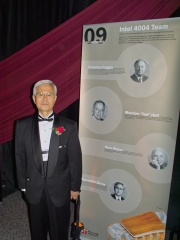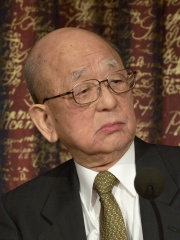
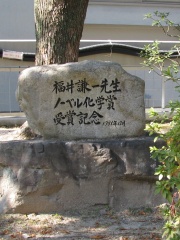
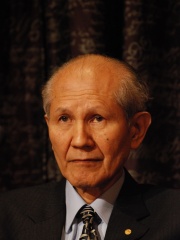
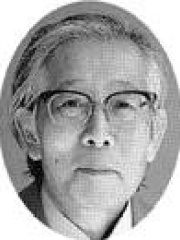
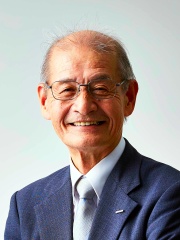
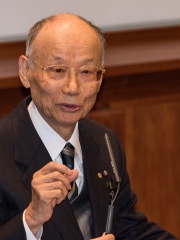
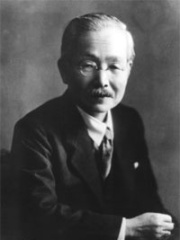
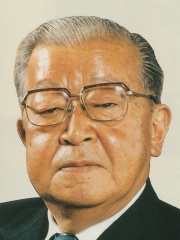
The Most Famous
CHEMISTS from Japan
This page contains a list of the greatest Japanese Chemists. The pantheon dataset contains 602 Chemists, 12 of which were born in Japan. This makes Japan the birth place of the 9th most number of Chemists behind Sweden, and Switzerland.
Top 10
The following people are considered by Pantheon to be the top 10 most legendary Japanese Chemists of all time. This list of famous Japanese Chemists is sorted by HPI (Historical Popularity Index), a metric that aggregates information on a biography's online popularity. Visit the rankings page to view the entire list of Japanese Chemists.

1. Akira Suzuki (b. 1930)
With an HPI of 70.85, Akira Suzuki is the most famous Japanese Chemist. His biography has been translated into 64 different languages on wikipedia.
Akira Suzuki (鈴木 章, Suzuki Akira; born September 12, 1930) is a Japanese chemist and Nobel Prize Laureate (2010), who first published the Suzuki reaction, the organic reaction of an aryl- or vinyl-boronic acid with an aryl- or vinyl-halide catalyzed by a palladium(0) complex, in 1979.

2. Kenichi Fukui (1918 - 1998)
With an HPI of 69.03, Kenichi Fukui is the 2nd most famous Japanese Chemist. His biography has been translated into 60 different languages.
Kenichi Fukui (福井 謙一, Fukui Ken'ichi; October 4, 1918 – January 9, 1998) was a Japanese chemist. He became the first person of East Asian ancestry to be awarded the Nobel Prize in Chemistry when he won the 1981 prize with Roald Hoffmann, for their independent investigations into the mechanisms of chemical reactions. Fukui's prize-winning work focused on the role of frontier orbitals in chemical reactions: specifically that molecules share loosely bonded electrons which occupy the frontier orbitals, that is, the Highest Occupied Molecular Orbital (HOMO) and the Lowest Unoccupied Molecular Orbital (LUMO).

3. Osamu Shimomura (1928 - 2018)
With an HPI of 68.88, Osamu Shimomura is the 3rd most famous Japanese Chemist. His biography has been translated into 63 different languages.
Osamu Shimomura (下村 脩, Shimomura Osamu; August 27, 1928 – October 19, 2018) was a Japanese organic chemist and marine biologist, and professor emeritus at Marine Biological Laboratory (MBL) in Woods Hole, Massachusetts and Boston University School of Medicine. He was awarded the Nobel Prize in Chemistry in 2008 for the discovery and development of green fluorescent protein (GFP) with two American scientists: Martin Chalfie of Columbia University and Roger Tsien of the University of California-San Diego.

4. Hideki Shirakawa (b. 1936)
With an HPI of 68.24, Hideki Shirakawa is the 4th most famous Japanese Chemist. His biography has been translated into 59 different languages.
Hideki Shirakawa (白川 英樹, Shirakawa Hideki; born August 20, 1936) is a Japanese chemist, engineer, and Professor Emeritus at the University of Tsukuba and Zhejiang University. He is best known for his discovery of conductive polymers. He was co-recipient of the 2000 Nobel Prize in Chemistry jointly with Alan MacDiarmid and Alan Heeger.

5. Ryōji Noyori (b. 1938)
With an HPI of 67.55, Ryōji Noyori is the 5th most famous Japanese Chemist. His biography has been translated into 61 different languages.
Ryōji Noyori (野依 良治, Noyori Ryōji; born September 3, 1938) is a Japanese chemist. He won the Nobel Prize in Chemistry in 2001, Noyori shared a half of the prize with William S. Knowles for the study of chirally catalyzed hydrogenations; the second half of the prize went to K. Barry Sharpless for his study in chirally catalyzed oxidation reactions (Sharpless epoxidation).

6. Akira Yoshino (b. 1948)
With an HPI of 66.59, Akira Yoshino is the 6th most famous Japanese Chemist. His biography has been translated into 56 different languages.
Akira Yoshino (吉野 彰, Yoshino Akira; born 30 January 1948) is a Japanese chemist. He is a fellow of Asahi Kasei Corporation and a professor at Meijo University in Nagoya. He created the first safe, production-viable lithium-ion battery, which became used widely in cellular phones and notebook computers. Yoshino was awarded the Nobel Prize in Chemistry in 2019 alongside M. Stanley Whittingham and John B. Goodenough.

7. Satoshi Ōmura (b. 1935)
With an HPI of 66.19, Satoshi Ōmura is the 7th most famous Japanese Chemist. His biography has been translated into 57 different languages.
Satoshi Ōmura (大村 智, Ōmura Satoshi; [oːmɯɾa saꜜtoɕi]; born 12 July 1935) is a Japanese biochemist. He is known for the discovery and development of hundreds of pharmaceuticals originally occurring in microorganisms. In 2015, he was awarded the Nobel Prize in Physiology or Medicine jointly with William C. Campbell for their role in the discovery of avermectins and ivermectin, the world's first endectocide and a safe and highly effective microfilaricide. It is believed that the large molecular size of ivermectin prevents it from crossing the blood/aqueous humour barrier, and renders the drug an important treatment of helminthically-derived blindness.

8. Kikunae Ikeda (1864 - 1936)
With an HPI of 66.12, Kikunae Ikeda is the 8th most famous Japanese Chemist. His biography has been translated into 28 different languages.
Kikunae Ikeda (池田 菊苗, Ikeda Kikunae; 8 October 1864 – 3 May 1936) was a Japanese chemist and Tokyo Imperial University professor of chemistry who, in 1908, uncovered the chemical basis of a taste he named umami. It is one of the five basic tastes along with sweet, bitter, sour and salty.

9. Kaoru Ishikawa (1915 - 1989)
With an HPI of 65.47, Kaoru Ishikawa is the 9th most famous Japanese Chemist. His biography has been translated into 23 different languages.
Kaoru Ishikawa (石川 馨, Ishikawa Kaoru; July 13, 1915 – April 16, 1989) was a Japanese organizational theorist and a professor in the engineering faculty at the University of Tokyo who was noted for his quality management innovations. He is considered a key figure in the development of quality initiatives in Japan, particularly the quality circle. He is best known outside Japan for the Ishikawa or cause and effect diagram (also known as the fishbone diagram), often used in the analysis of industrial processes.
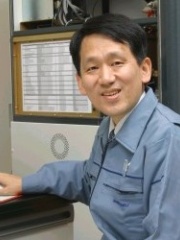
10. Koichi Tanaka (b. 1959)
With an HPI of 60.53, Koichi Tanaka is the 10th most famous Japanese Chemist. His biography has been translated into 60 different languages.
Koichi Tanaka (田中 耕一, Tanaka Kōichi; born August 3, 1959) is a Japanese electrical engineer who shared the Nobel Prize in Chemistry in 2002 for developing a novel method for mass spectrometric analyses of biological macromolecules with John Bennett Fenn and Kurt Wüthrich (the latter for work in NMR spectroscopy).
People
Pantheon has 12 people classified as Japanese chemists born between 1854 and 1959. Of these 12, 7 (58.33%) of them are still alive today. The most famous living Japanese chemists include Akira Suzuki, Hideki Shirakawa, and Ryōji Noyori. The most famous deceased Japanese chemists include Kenichi Fukui, Osamu Shimomura, and Kikunae Ikeda.
Living Japanese Chemists
Go to all RankingsAkira Suzuki
1930 - Present
HPI: 70.85
Hideki Shirakawa
1936 - Present
HPI: 68.24
Ryōji Noyori
1938 - Present
HPI: 67.55
Akira Yoshino
1948 - Present
HPI: 66.59
Satoshi Ōmura
1935 - Present
HPI: 66.19
Koichi Tanaka
1959 - Present
HPI: 60.53
Masatoshi Shima
1943 - Present
HPI: 57.37
Deceased Japanese Chemists
Go to all RankingsKenichi Fukui
1918 - 1998
HPI: 69.03
Osamu Shimomura
1928 - 2018
HPI: 68.88
Kikunae Ikeda
1864 - 1936
HPI: 66.12
Kaoru Ishikawa
1915 - 1989
HPI: 65.47
Takamine Jōkichi
1854 - 1922
HPI: 54.62
Overlapping Lives
Which Chemists were alive at the same time? This visualization shows the lifespans of the 5 most globally memorable Chemists since 1700.

